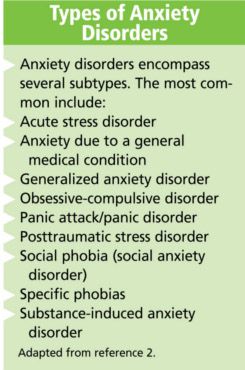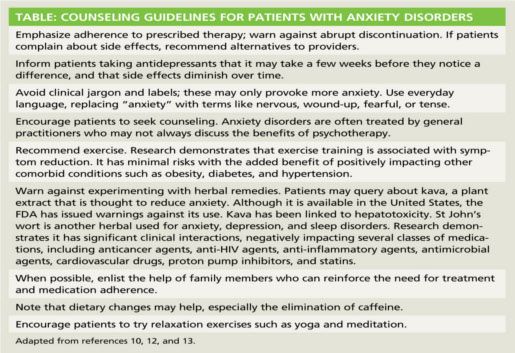Publication
Article
Pharmacy Times
Anxiety Disorders: Underdiagnosed and Undertreated
Author(s):
Social stigma may cause some patients to be hesitant to discuss their anxiety disorder, making pharmacist counseling even more important.

Social stigma may cause some patients to be hesitant to discuss their anxiety disorder, making pharmacist counseling even more important.
Anxiety disorders—characterized by somatic symptoms (restlessness, fatigue, poor concentration, irritability, muscle tension, or sleep disturbances) coupled with excessive worrying, apprehension, or fear—are among the most common psychiatric conditions encountered in primary care settings.1,2 Lifetime prevalence is estimated at 16.6%, affecting women disproportionately. One analysis of National Institute of Mental Health data found that 6% of men and 13% of women had experienced a clinically diagnosable anxiety disorder within a 6-month period.3
Disease burden is significant. The impact on quality of life is comparable to that of clinical depression and chronic physical illnesses such as arthritis and diabetes.4 Social phobias result in the most severe functional impairments and decreased quality of life.5
Anxiety disorders have high rates of comorbidity with depression and alcohol and drug abuse.6 Up to 75% of those with an anxiety disorder meet criteria for a comorbid psychiatric disorder.7 Other comorbid conditions include cardiovascular disease, diabetes, asthma, and irritable bowel syndrome.8 Longterm anxiety is an independent predictor of myocardial infarction among men.4
Pathophysiology involves the central nervous system. The brain amygdala appears key in modulating fear and anxiety, with symptom mediation involving norepinephrine, serotonin, dopamine, and gamma-aminobutyric acid.6 Disease onset typically occurs early in life.
Risk factors include marital status (single, divorced, or widowed), low socioeconomic status, disproportionate exposure to stressful events, and history of trauma or abuse.1 Genetics are likewise involved. Among monozygotic twins, for example, there is 80% to 87% concordance for obsessive-compulsive disorders (OCDs).6

Treatment
Pharmacotherapy
Despite anxiety’s prevalence, it remains underdiagnosed and undertreated, especially in cases of moderate anxiety and/ or cases involving a single phobia (eg, fear of heights).
Selective serotonin reuptake inhibitors (SSRIs) or selective norepinephrine reuptake inhibitors (SNRIs) are the initial choices for treatment-naïve patients for several anxiety subtypes.1 SSRIs (fluoxetine, sertraline, escitalopram, paroxetine) are commonly prescribed for panic disorder (PD), OCD, posttraumatic stress disorder (PTSD), and social phobia. The SNRI venlafaxine is FDA-approved for generalized anxiety disorder (GAD), PD, and social phobia.
Antidepressants are generally started at low doses and titrated upward. Some of the older tricyclic antidepressants also work well for anxiety. For example, imipramine is prescribed for PD and GAD. Clomipramine is used to treat OCD and PD. Although not firstline treatments, some practitioners use monoamine oxidase inhibitors (phenelzine, tranylcypromine, isocarboxazid) to treat anxiety disorders.9,10
Finally, second-generation antipsychotics (eg, quetiapine, risperidone, olanzapine, aripiprazole) are effective, but given their side effects, these agents are generally used for treatment-refractory patients.1,9 No drug class can be judged superior because all are associated with at least a 50% response rate, which is the criterion for defining a positive treatment response.1,9
Acute anxiety episodes are treated with benzodiazepines. Clonazepam is used as treatment for social phobia, PD, and GAD, and both lorazepam and alprazolam can be used in treating PD and GAD.9,10 Treatment guidelines do not recommend benzodiazepines as first-line agents; however, they may be used short-term until other agents take effect.9 One exception is PD, which may require a longer trial.
Although buspirone is an approved alternative to benzodiazepines, it is not a first-line agent for acute episodes, partly because it has no effect on depression (a common comorbid condition), and there is a 1 to 3 week delay for symptom relief.11 In addition, previous exposure to benzodiazepines seems to limit buspirone’s efficacy.1 Beta-blockers (eg, propranolol) help control acute somatic symptoms such as trembling and sweating.
Psychotherapy
Research demonstrates that psychotherapy is equally effective as medication with less attrition.11 Cognitive behavioral therapy (CBT) is the most extensively studied approach and is also considered a first-line treatment.
CBT begins with the premise that anxiety results from a patient’s tendency to overestimate the potential for danger and imagine the worst outcome possible. Its focus is to train the patient to perceive and react differently to anxiety-provoking thoughts and stimuli. CBT is short-term; positive outcomes are generally achieved over a 12-week period. Internet-based CBT interventions have been used with some success, especially for phobias, PDs, and PTSD.12
Counseling Tips
Like many patients with mental illnesses, individuals experiencing anxiety disorders may have encountered ridicule and bias, with friends and family members telling them to “just snap out of it.” Patients are relieved when someone takes their complaints seriously.
Counseling must emphasize that anxiety disorders are real diseases caused by changes in brain chemistry, and that they are manageable medical conditions (Table). When treatment-naïve patients ask about a product that might “calm the nerves,” use the opportunity to encourage the individual to see a professional.

Final Thought
Anxiety disorders are generally chronic and unremitting, but with treatment, disease burden is significantly reduced, and quality of life can be improved.
Dr. Zanni is a psychologist and health-systems consultant based in Alexandria, Virginia.
References
1. Collins K, Mathew s. Current evidence in the treatment of generalized anxiety disorder. Available at www.medscape.org/viewarticle/590285_2. Accessed June 17, 2012.
2. Diagnostic and Statistical Manual of Mental Disorders, Fourth Edition, Text Revision (DSM-IV-TR). Washington, DC: American Psychiatric Association; 2000.
3. Leon AC, Portera L, Weissman MM. The social costs of anxiety disorders. Br J Psychiatry Suppl. 1995;(27):19-22.
4. Shen BJ, Avivi YE, Todaro JF, Spiro A 3rd, Laurenceau JP, Ward KD, Niaura R. Anxiety characteristics independently and prospectively predict myocardial infarction in men the unique contribution of anxiety among psychologic factors. J Am Coll Cardiol. 2008;51:113-9.
5. Lochner C, Mogotsi M, du Toit PL, et al. Quality of life in anxiety disorders: a comparison of obsessive-compulsive disorder, social anxiety disorder, and panic disorder. Psychopathology. 2003;36:255-62.
6. Yates WR. Anxiety disorders. Available at http://emedicine.medscape.com/article/286227-overview. Accessed June 10, 2012.
7. Kessler RC, McGonagle KA, Zhao S, Nelson CB et al. Lifetime and 12-month prevalence of DSM-III-R psychiatric disorders in the United States. Results from the National Comorbidity Survey. Arch Gen Psychiatry. 1994;51:8-19.
8. Roy-Byrne PP, Davidson KW, Kessler RC, et al. Anxiety disorders and comorbid medical illness. Gen Hosp Psychiatry. 2008;30:208-25.
9. Koen N, Stein DJ. Pharmacotherapy of anxiety disorders: a critical review. Dialogues Clin Neurosci. 2011;13:423-37.
10. National Institute of Mental Health. Mental Health Medications. Available at www.nimh.nih.gov/health/publications/mental-health-medications/complete-index.shtml. Accessed June 20, 2012.
11. Kavan MG, Elsasser G, Barone EJ. Generalized anxiety disorder: practical assessment and management. Am Fam Physician. 2009;79:785-91.
12. Morgan AJ, Jorm AF. Outcomes of self-help efforts in anxiety disorders. Expert Rev Pharmacoecon Outcomes Res. 2009;9:445-59.
13. Herring MP, O'Connor PJ, Dishman RK. The effect of exercise training on anxiety symptoms among patients: a systematic review. Arch Intern Med. 2010;170:321-31.







